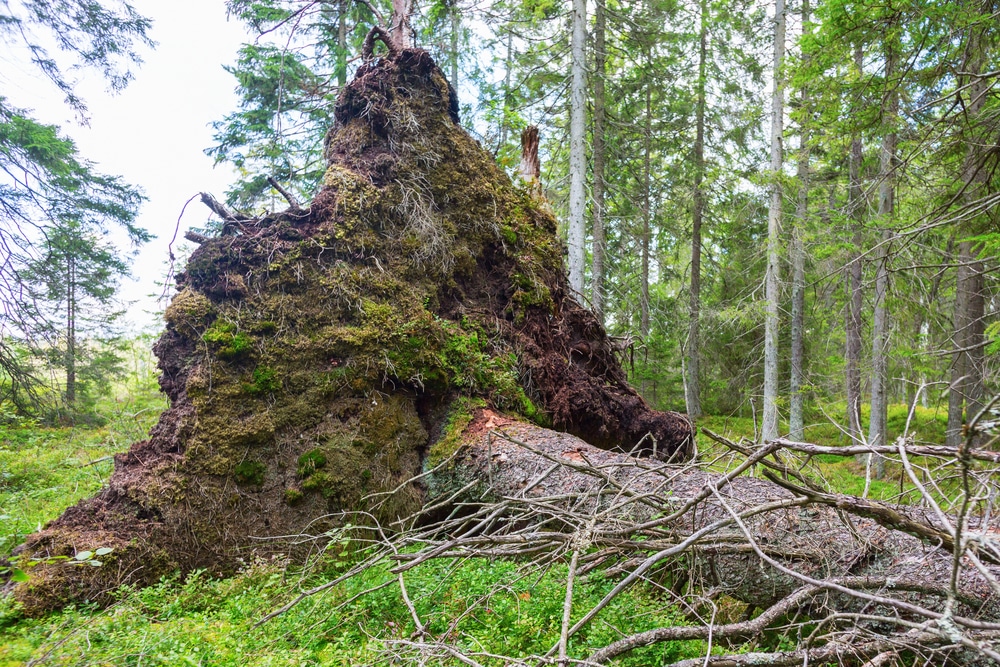Can You Replant Uprooted Trees?
Is it possible to save a tree that has been uprooted? Maybe you have a tree in your yard that has fallen over in a storm or a tree that was dug up during construction. Whatever the reason, you may wonder if it’s too late to save your beloved tree.
Thankfully, the answer is that it is possible to replant uprooted trees. However, success depends on several factors, such as the size and age of the tree, the extent of root damage, and how long the tree has been uprooted.
In some cases, uprooted trees may not survive or recover, especially if the roots have been severely damaged or the tree has been uprooted for an extended period of time. If the uprooted tree is still alive and has a relatively intact root system, you may replant it successfully with proper care and attention.
In general, replanting an uprooted tree typically involves digging a new hole, pruning any damaged or broken branches, carefully transferring the tree to the new spot, backfilling with soil, and then providing the tree with appropriate care as regular watering, mulching, and fertilizing. You should also ensure the tree is well-supported and anchored in the new hole, especially in windy or stormy weather.
What Causes Trees to Uproot?
Trees can uproot for various reasons, including natural forces such as strong winds, floods, and landslides, as well as human activities like construction, digging, and soil compaction.
Strong Winds
Strong winds can uproot trees, especially if the soil is saturated or the roots are weakened by disease or decay. Trees with shallow root systems are more prone to uprooting than those with deep roots.
Wind can uproot trees by exerting a significant force on the tree trunk and branches, thus causing the roots to lose their grip on the soil. Furthermore, the wind’s energy creates a pressure differential on opposite sides of the tree trunk. This pressure difference can cause the tree to bend and sway, which places additional stress on the roots. If the wind speed is strong enough, the roots may not be able to withstand the pressure, and the tree can uproot.
Trees with shallow root systems are more susceptible to uprooting than deep root systems because their roots are not anchored as firmly in the soil. Another factor is the soil moisture content. Trees growing in saturated or waterlogged soil are more likely to uproot because the soil is softer, and the roots may not hold on to the ground as firmly.
Soil Erosion
Soil erosion can be caused by various natural factors, including heavy rainfall, floods, landslides, and wind erosion. Trees growing on steep slopes or near rivers and streams may uproot since corrosion weakens the soil around the tree roots and makes them more susceptible to uprooting.
When soil erosion occurs, the top layer of soil is washed away or blown away, exposing the tree’s roots. This makes it harder for the roots to hold on to the ground, making the tree less stable.
Additionally, soil erosion can also cause changes in the topography and slope of the land, which can affect the weight distribution of the tree roots. This, too, makes the tree less stable and increases the risk of uprooting
Soil Saturation
While trees need water to thrive, water can be too much of a good thing in the case of soil saturation. When the soil becomes saturated, the water’s weight can make the tree roots less stable. It also compresses the soil and reduces the air space between soil particles. This can limit the roots’ ability to absorb oxygen and nutrients, weakening their anchoring ability. Additionally, saturated soil can become more acidic and contain fewer nutrients.
When the soil is saturated for a prolonged period, the roots may begin to decay, compromising their anchoring ability and making the tree more prone to uprooting. Also, the water makes the soil softer and reduces the power of the roots to hold onto the ground.
Soil Compaction
Construction activities, heavy foot traffic, and other human activities can cause soil compaction, making it difficult for tree roots to grow and absorb nutrients. This can weaken the tree roots and make them more prone to uprooting. It also limits the growth and anchoring ability of its origins. The soil particles are tightly packed together, reducing the air and water in the soil.
In addition to limiting root growth, soil compaction can make it harder for the tree roots to anchor themselves in the soil. Roots find it hard to penetrate hard soil and establish a stable anchor. This can make the tree susceptible to uprooting, especially during strong winds or heavy rains.
Disease or Decay
Trees that are diseased or decaying become weaker and more brittle. As a result, a sick tree may be unable to support its own weight, making it more prone to uprooting during strong winds or other external factors.
In addition to weakening the wood, disease or decay can affect the tree’s root system. As the roots decay, they become less effective at anchoring the tree in the soil, making it more susceptible to uprooting.
Common causes of disease-related uprooting include root rot, canker, and heart rot. These conditions can be caused by various factors, such as fungal or bacterial infections, insect infestations, or environmental stressors.
Can I Save an Uprooted Tree?
While saving an uprooted tree is possible, the chances of success depend on several factors. These include the size and type of tree, the extent of the root damage, and the length of time the tree has been uprooted. Smaller trees have a better chance of survival than larger trees, as their root systems are less extensive and easier to replant.
The longer the tree remains uprooted, the less likely it is to survive. If the tree has been uprooted for only a short period, there is a greater chance of saving it. Thus, acting quickly is essential to increase the chances of success.
So, replant the uprooted tree as soon as possible. Dig a hole wider and deeper than the root ball and carefully place the tree back into the hole. Ensure the tree is straight and upright, and water it thoroughly to ensure the roots are well hydrated.
After replanting, stake the tree to support it and prevent it from moving while the roots re-establish themselves. Prune any broken or damaged branches to prevent further stress on the tree. However, don’t prune too much, as the tree needs its leaves to produce energy through photosynthesis.
Keep the soil moist but not waterlogged to encourage root growth and provide nutrients by adding fertilizer to the soil around the tree.
The tree may take several years to recover fully, and there is no guarantee of success. To maximize its chances of survival, monitor it regularly for signs of stress or further damage and be patient.
If you are unsure how to save an uprooted tree, or if it is large or valuable, it is best to consult a professional such as EDI for assistance.
Large Trees vs. Small Trees
Saving an uprooted large tree is generally more challenging than keeping a small one. The larger the tree, the more extensive its root system, and the heavier it is—making it more challenging to replant and support.
When handling and transporting large trees, you will need specialized equipment to move them, such as a crane or a hydraulic lift. Moving a large uprooted tree can thus be challenging and requires trained professionals. In contrast, a small uprooted tree can be moved by hand or with essential tools.
Similarly, large trees require replanting a giant hole, which takes more time and effort to dig. After all, you must replant the tree at the correct depth with its roots well covered by soil—which is far easier with a small tree.
In addition, you must place stakes at the proper distance from the trunk to avoid damaging the roots. Large trees obviously require more stakes and support to prevent them from falling or tilting. In contrast, a small tree may only need one or two stakes to keep it upright.
Given the above differences, it is hardly surprising that large trees take longer to recover from uprooting than small trees. Indeed, it may take several years for a large tree to fully recover, which may require regular care and monitoring. A small tree, on the other hand, may recover within a few months.
Since saving an uprooted large tree requires more effort, specialized equipment, and plenty of expertise compared to holding a small tree, your best bet is to seek professional help and consult an arborist.
Partially Uprooted Trees
A unique case concerns partially uprooted trees.
An uprooted tree has been completely removed from the ground, with its roots exposed and disconnected from the soil.
In contrast, a partially uprooted tree has had some roots damaged or lifted out of the soil but is still somewhat connected to the ground. In such a case, it may be possible to gently push it back into place and cover the exposed roots with soil. However, it is important to ensure that the tree is replanted at the correct depth and that the soil is firmly packed around the roots to prevent further damage.
Hopefully, the tree will still be stable enough to stand independently. It may require additional support to prevent it from tilting or falling over. Use stakes to anchor it to the ground until its roots are re-established.
Next comes pruning. It’s not unusual for partially uprooted trees to have damaged branches or bark that need to be pruned to prevent further stress on the tree. Prune conservatively, as the tree still needs its leaves to produce energy through photosynthesis.
Finally, you need to water and fertilize it. Partially uprooted trees may require additional watering and fertilization to help them recover from the shock of the damage. Water the tree thoroughly after replanting and provide regular applications of fertilizer to help the tree regrow its roots.
As with large trees, it is best to consult a professional arborist if you are unsure how to save a partially uprooted tree, if the tree is precious, or if the damage is severe.
How Long Are Uprooted Trees Viable?
The viability of uprooted trees depends on various factors, including the size of the tree, the extent of the root damage, the time elapsed since uprooting, and the care provided to the tree afterward. Generally, the longer a tree remains uprooted, the less viable it becomes. Viability is also related to the tree’s size, among other factors:
- Small trees: Small trees with shallow roots may be viable for several hours to a day after uprooting if replanted promptly and given proper care. However, if the roots are severely damaged or the tree has been uprooted for over a day, it may not survive.
- Medium-sized trees: Medium-sized trees with deeper roots may be viable for up to a few days after uprooting if they are replanted promptly, given proper care, and staked to prevent them from falling over. However, if the roots are severely damaged or the tree has been uprooted for over a few days, it may not survive.
- Large trees: Large trees are less viable than small or medium-sized trees, requiring a more extensive root system to support their size and weight. Large trees that have been uprooted may not survive, even if replanted promptly and given proper care. It is essential to seek the help of trained professionals when replanting a large tree.
In addition to the above factors, several other factors can determine how long an uprooted tree can survive.
These include:
- The tree species: Different tree species have different tolerances to stress and damage. Some species are more resilient than others and may have a better chance of surviving after uprooting.
- The tree’s age: Older trees may have a more extensive root system and be less likely to survive uprooting than younger trees with shallower roots.
- The tree’s overall health: Trees already stressed or unhealthy are less likely to survive uprooting. For example, trees that have been affected by pests, disease, or environmental stressors may have a weakened root system and be more susceptible to uprooting.
- Season: The time of year can also affect the viability of uprooted trees. Trees that are uprooted during the growing season (spring and summer) have a better chance of survival than those uprooted during the dormant season (fall and winter) when the tree’s metabolic activity is lower.
- Location: Trees uprooted from a protected location are typically more likely to survive than those uprooted from an exposed or windy location.
- Soil conditions: The soil type and quality can also affect uprooted trees’ viability. Trees uprooted from well-draining soils are more likely to survive than those uprooted from poorly-draining soils.
So, consider all these factors when attempting to save an uprooted tree and ask for a professional arborist’s help if necessary.
Replanting Uprooted Trees
Replanting an uprooted tree is a complex process that requires careful planning and execution.
The first step is to assess the extent of the damage accurately. Look for root damage or other signs of stress or disease. If the tree is severely damaged, replanting may be impossible.
Next, prepare the new planting hole, which should be wide and deep enough to accommodate the tree’s root system. Make it twice as wide as the root ball and just as deep. Avoid compacting the soil in the hole, as this can prevent the roots from growing.
Before you plant the tree, prune any damaged or broken roots using clean, sharp tools. This helps prevent infection and encourages the growth of healthy roots.
With the roots carefully prepared, place the tree into the planting hole and backfill it with soil, ensuring it is level and straight. Gently tamp the soil around the roots to remove any air pockets. Avoid over-compacting the ground to prevent any further damage to the roots. If the tree is large or heavy, it may need to be staked to provide support until the roots have had a chance to reestablish themselves.
Water the tree thoroughly after planting, ensuring the soil is moist but not waterlogged. Water it regularly, especially during the first few weeks after replanting. Also, apply a layer of mulch around the tree’s base, ensuring not to cover the trunk. Mulch will help to retain moisture and suppress weeds.
Finally, monitor the tree regularly for signs of stress or disease and provide care as needed.
Caring for Uprooted Trees After Transplanting
After replanting an uprooted tree, provide it with proper care to help it thrive. The steps involved are similar to those you followed when replanting it.
Water it regularly, especially during the first year after replanting. Also, apply a layer of mulch around the base of the tree. Mulch will help to retain moisture, suppress weeds, and regulate soil temperature. Avoid piling the mulch against the trunk and apply a balanced fertilizer to the tree during the growing season to give it the nutrients it needs to grow.
When it’s time to prune the tree to remove dead or damaged branches, avoid pruning too much, especially during the first year after replanting. Monitor it regularly for signs of stress or disease, such as wilting leaves or discoloration. If you notice any problems, take action immediately to address them.
The tree has already been through the shocks of uprooting and replanting, so be extra careful around it. Avoid damaging it with lawnmowers, weed whackers, or other equipment, and keep the area around it clear of debris and other obstacles.
Finally, be patient! It may take some time for the tree to recover and fully grow. The larger the tree, the more time it will need. Be patient and continue to provide it with proper care and attention.
When in Doubt, Call Environmental Design
Trees are essential to our environment, providing oxygen, shade, and beauty. Losing a tree can be a devastating experience, both emotionally and environmentally. However, there is hope for uprooted trees if you take the steps detailed above.
If you are unsure about replanting an uprooted tree, or if the tree appears to be dead or severely damaged, consult a certified arborist or tree care professional for advice and assistance. They can assess the tree’s condition, recommend the best course of action, and help you replant it if possible.
EDI can help with replanting large uprooted trees. Our arborists are the secret behind the high rate of success of our projects, and we trust them to give us the best advice on tree care, tree health, and tree maintenance. Call us today at (800) 376 – 4260 or visit Environmental Design Inc. online to discuss your needs. We have offices in Texas, California, and Minnesota and move trees across the United States and abroad.




Recent Comments